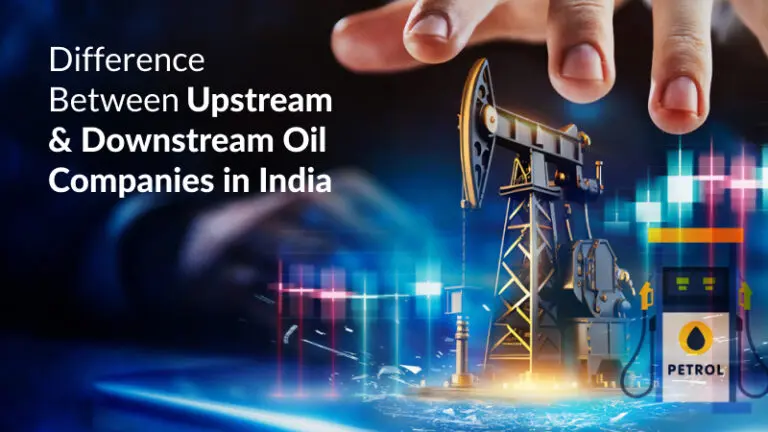
Table of Content
India’s rapid economic growth has fueled an insatiable demand for oil and petroleum products as the world’s third largest oil consumer on the side
of the US and China. India’s energy needs are met through a combination of domestic production and imports. This article analyses the crucial role played by upstream and downstream oil companies in satisfying India’s oil appetite today and powering future growth.
Read on to understand what upstream and downstream oil companies are, their key players in India, and how they operate to keep the country moving.
Upstream oil companies specialise in the initial exploration and production (E&P) phases of the oil supply chain. Their main functions are to locate potential underground or underwater oil and natural gas fields, drill exploratory wells, and operate drills that extract crude oil.
Once oil is discovered and extracted from wells, upstream producers transport it via pipelines, ships, trucks or railcars to refineries owned by downstream companies.
Downstream firms focus on the later refining, marketing and distribution links in the oil value chain. They convert crude oil into finished end-products like petrol, diesel, aviation fuel, lubricants, asphalt and petrochemical feedstocks. Downstream activities also encompass storage, transportation and retail sales of fuels to businesses, governments and general consumers.
Indian Oil Corporation (IOC) is a big oil company in India. It has 11 refineries where it processes oil and makes different kinds of fuel that people use. IOC also has many gas stations across the country where people can buy fuel for their vehicles. In fact, more than half of all fuel sold in India comes from IOC’s gas stations.
The government mostly runs oil companies in India. But in recent years, private companies have also started to participate in the market with the help of the government.
The government has made it easier for companies to explore and produce oil and gas by giving them incentives. This has led to an increase in the amount of oil and gas produced in India.
The government also helps companies that refine oil by giving them subsidies on the crude oil they import and the byproducts they produce.
Overall, the government has played a big role in helping both government-run and private oil companies succeed in India.
To accelerate upstream capacity, India has implemented several production-sharing contracts (PSCs) that allow private energy majors to explore and operate domestic oil blocks and fields.
Liberal policies also permit 100% foreign direct investment (FDI) in oil and gas exploration ventures. This has attracted global giants like ExxonMobil and BP to deploy technology and capital into India’s upstream segment alongside state-run ONGC and OIL.
In 2022, the Modi government also unveiled a new incentive scheme for enhanced oil recovery (EOR) from maturing fields. EOR techniques can help ageing oil wells maintain viable production rates.
Downstream expansion is crucial for ensuring India’s refining capacity keeps pace with surging diesel and gasoline consumption.
Refinery upgrades receive fiscal incentives like concessional import duties on capital equipment. Once operational, certain refinery infrastructure is exempt from excise taxes.
State retailers IOC, BPCL and HPCL also obtain raw material crude oil from overseas at subsidised rates. This ensures their financial health and sustainable expansion of India’s refining backbone.
India’s oil demand is projected to sustain strong growth as its economy continues modernising and expanding. Hence, bolstering upstream output and downstream refining capacity remains vital for national energy security.
ONGC aims to raise domestic oil and gas production by 25% in the next 5 years as new blocks open up in unexplored regions. Downstream players are targeting total refining throughput to reach 300 million tons by 2030.
While public sector firms still dominate oil and gas value chains, increased private investment can inject fresh technologies and efficiency. Jio-BP’s just-launched chain of mobility stations providing petrol, diesel and EV charging presents this new-age integration of fuel retail with sustainability.
India is one of the biggest users of energy in the world. To make sure that India has enough energy for everyone, both the government and private companies need to work together. This means working on all aspects of energy, from getting it out of the ground to delivering it to homes and businesses. India can also focus on making more of its energy and using new technologies like renewable energy. By doing all of this, India can become a leader in energy and make sure that everyone has enough energy for years to come.
The government offers production incentives and subsidies to upstream drillers to boost domestic oil output. Downstream players get import duty cuts and tax breaks to expand critical refining capacity.
Private equity can accelerate technology and efficiency improvement across exploration, production, refining, storage and distribution links in India’s hydrocarbon value chain.
![]() IIFL Customer Care Number
IIFL Customer Care Number
(Gold/NCD/NBFC/Insurance/NPS)
1860-267-3000 / 7039-050-000
![]() IIFL Capital Services Support WhatsApp Number
IIFL Capital Services Support WhatsApp Number
+91 9892691696
IIFL Capital Services Limited - Stock Broker SEBI Regn. No: INZ000164132, PMS SEBI Regn. No: INP000002213,IA SEBI Regn. No: INA000000623, SEBI RA Regn. No: INH000000248, DP SEBI Reg. No. IN-DP-185-2016, BSE Enlistment Number (RA): 5016
ARN NO : 47791 (AMFI Registered Mutual Fund Distributor), PFRDA Reg. No. PoP 20092018

This Certificate Demonstrates That IIFL As An Organization Has Defined And Put In Place Best-Practice Information Security Processes.